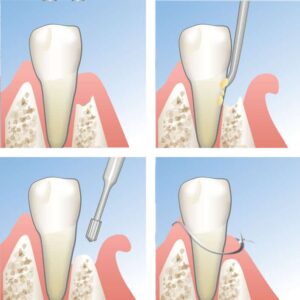Osseous Surgery: Reducing Periodontal Pockets with Advanced Dental Deep Cleaning
What is osseous surgery?
Osseous surgery, also known as a periodontal pocket reduction procedure, is a common surgical technique used to treat advanced periodontal disease. This procedure smoothens the irregularities in the underlying bone, helping to restore oral health.
Benefits of Osseous Surgery
- Decreased pocket depth
- Improved brushing as a toothbrush can reach more areas
- Greater comfort during teeth cleaning at a dental office
- Fresher breath
- Reduced gum bleeding
- Overall healthier mouth
What Happens During Osseous Surgery?
- A local anesthetic is administered to numb your gums.
- Dr. Adatrow will make a small incision around the gumline, then fold the gums back to eliminate bacteria underneath. Any damaged or irregularly shaped bone is then smoothed.
- If the bone is severely damaged, a bone graft and guided tissue regenerative membranes might be necessary—known as periodontal regeneration techniques.
- The gums are repositioned and covered with a periodontal dressing to control bleeding.
What is a Bone Graft?
A bone graft replaces lost bone in the jaw. If the upper jaw lacks teeth or bone, a bone graft can stimulate bone growth, reshaping the jaw and preparing it for dental implants.
How Does Osseous Surgery Work?
In osseous surgery, the diseased root and bone are accessed, and the infected gums and bacteria are removed. This reduces periodontal pockets and improves oral health. The procedure also reshapes the gum and jawbone to adhere more closely to the teeth, facilitating better plaque removal. Tooth length and spacing between teeth are enhanced. Post-surgery, some patients may experience reduced temperature sensitivity. During recovery, using toothpaste designed for sensitive teeth may be recommended. If the gum tissue in the front of the mouth is limited, alternative treatments may be considered depending on the extent of the condition.

Why Did Dr. Adatrow Recommend Osseous Surgery?
Osseous surgery is recommended when periodontal pockets are too deep to clean effectively with regular oral hygiene and professional treatment. Healthy bone and gum tissue should fit snugly around the teeth, creating a barrier against bacteria. Osseous surgery helps establish this protective cover.
Post-Operative Medications
You will likely experience some pain after osseous surgery, so taking painkillers is essential. You may be advised to take 400-600 mg of ibuprofen every 6-8 hours. If you cannot take ibuprofen, Tylenol® is an alternative. For more severe pain, Dr. Adatrow may prescribe Vicodin and an antibiotic to control infection. If severe pain persists, or you encounter other issues after the surgery, please contact us.
Can Osseous Surgery Be Performed Under Sedation?
Yes, sedation can help reduce anxiety and allow Dr. Adatrow to treat you more effectively. You must share your medical history with Dr. Adatrow to determine the best sedation option for you.
When is Osseous Surgery Recommended?
Osseous surgery is recommended when the bone supporting your teeth is damaged. If scaling and root planing—a non-surgical treatment—fails, osseous surgery may be necessary. This procedure uses incisions and ablation to remove infected gum tissue and damaged bone, creating a healthier environment, slowing the progression of periodontal disease, and improving long-term oral maintenance. The surgery may be performed on specific parts of the mouth or across all affected areas. Staggering treatment times across different mouth regions can minimize complications by reducing tissue damage. Treating all affected areas is crucial, as untreated spots can re-infect treated areas.


